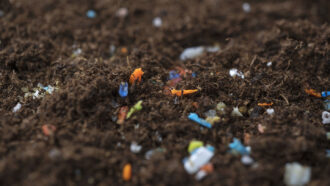Replacement ‘plastic’ may be as risky as BPA
Mounting evidence suggests BPS poses the same health risks being reported for BPA, a common ingredient in plastics

Many plastic water bottles have been made from BPA-based polycarbonate. When concerns over BPA emerged, some companies offered “BPA-free” alternatives. For now, no user will know if the newer plastic contains the related — and potentially just as worrisome — BPS.
Andrew Catellier /Flickr (CC BY-NC-SA 2.0)
By Beth Mole
Not so long ago, scientists found some disturbing evidence about a common chemical. Known as bisphenol A, or BPA, it is the basic building block of many hard-plastic bottles and other products. In 2012, the U.S. Food and Drug Administration, or FDA, banned BPA’s use in baby bottles. Some companies stopped using BPA in other products as well. Many replaced this “plasticizer” with bisphenol S, or BPS. But BPS appears to have the same toxic, hormone-like effects in cells and animals as BPA, new data show.
The not-so-rosy findings are the latest to raise concerns about BPS. The studies also suggest that baby bottles and other products labeled “BPA-free” may not be any safer than those made with the now-banned BPA.
BPA got its bad reputation after researchers found links between the chemical and obesity, heart disease, cancers, infertility, nerve problems and asthma. The chemical is known as an endocrine disruptor. The endocrine system relies on hormones to tell cells throughout the body when to turn on and do their thing. But some pollutants, such as BPA, can disturb this system by mimicking a hormone. In BPA’s case, it mimics estrogen, the body’s primary female sex hormone.
Scientists are still working to understand all of the potential health effects of BPS. But there are reasons to think that BPS might be as concerning as those of its close chemical cousin, BPA.
BPA consists of two identical, sturdy ring structures. Those rings are linked by carbon and hydrogen atoms. BPS has the same ring structure. But its identical rings are linked by a sulfur atom with two oxygen atoms.Indeed, “based on the structural similarity,” you might expect that they would behave similarly, says Kurunthachalam Kannan. He’s an environmental chemist with the New York State Department of Health, in Albany.
Concerns now that BPS is widely used
Plastic bottles, bowls, drinking glasses and more have been among the most common products made from BPA. Many companies have swapped BPS for the BPA in these products. But these products are far from the only ones using BPA or BPS. Cash register receipts made with thermal paper have become a growing market for both chemicals. This paper relies on heating to activate its “ink.”
Around 2009, concerns began to build about the potential risks that handling a BPA-laced paper might pose. In short order, paper companies quickly looked for a replacement. Within a year, one of the largest U.S. makers of thermal paper announced it was giving up BPA. It’s replacement: BPS.
Within two years, Kannan showed that BPS had become a common replacement for BPA in paper. When BPS was present, BPA usually wasn’t, he reported. Indeed, by 2012 thermal paper used for store receipts appeared to contain only BPS, Kannan and his colleagues found.
Not surprisingly, BPS has been making its way into people.
In another 2012 study, Kannan and his co-workers reported that 81 percent of the 315 people they tested had been exposed to BPS. How did they know this? All of these people excreted the chemical in their urine. At the time, however, researchers had little data on what health impacts those internal exposures might pose.
“The study of BPS has only recently started,” says Hong-Sheng Wang. He is a pharmacologist at the University of Cincinnati in Ohio.
Wang recently led another study that looked at the effects of BPA and BPS on rat hearts. In that study, both chemicals caused the rats’ hearts to speed up. Then the researchers added a chemical that mimics the effect of stress on the heart. Both BPA and BPS caused irregular heartbeats in the rats. The study was published February 26 in Environmental Health Perspectives.
If similar things happen in people, Wang says it could mean that BPS might lead to heart damage. Or the chemical could put people with pre-existing heart conditions or stressful lives at risk for heart disease. Scientists have already linked exposure to BPA to higher risks of heart disease.
Wang says he’s amazed by how similar the effects of BPS are to those of BPA. “They are nearly indistinguishable, if not identical,” he says.
Heart changes occurred only in female rats, not males, Wang notes. Both BPA and BPS act as a weak estrogen. The heart cells in male mice have a way of blocking that estrogen signal; the heart cells in female rats don’t. It’s unclear, Wang says, whether the same would be true in men.
In another recent study, this time in zebrafish, researchers showed that by mimicking estrogen, BPS — like BPA — causes problems. These researchers exposed young fish to BPS at low levels. How low? They were equal to the levels of BPA that had been reported polluting nearby waterways. In this study, BPS spurred early development of nerve cells in a part of the brain that is responsive to estrogen. This region is called the hypothalamus.
Such premature development could cause sweeping changes in function since brain development is a precisely timed, well-orchestrated process, says Cassandra Kinch. A neuroscientist at the University of Calgary in Canada, she led the zebrafish study.
When her fish grew up, they were hyperactive. They zoomed around their tanks in circles, she says. In people, BPA exposure has also been linked to behavioral changes such as hyperactivity. Kinch’s team reported its findings February 3 in the Proceedings of the National Academy of Sciences.
More such animal studies should be performed, says Daniel Zalko. He is a toxicologist at the INRA Research Centre in Food Toxicology in Toulouse, France. It took years to collect data on BPA, he notes. He hopes it will take less time to do similar safety analyses of BPS.
Yet, despite the data on BPA, it’s still found in many plastic products. In the United States, there are few restrictions on its use in anything other than baby products. And there are no bans on use of BPS or the many other bisphenol chemicals used in plastics today.
Power Words
(for more about Power Words, click here)
asthma A disease affecting the body’s airways,which are the tubes through which animals breathe. Asthma obstructs these airways through swelling, the production of too much mucus or a tightening of the tubes. As a result, the body can expand to breathe in air, but loses the ability to exhale appropriately. The most common cause of asthma is an allergy. It is a leading cause of hospitalization and the top chronic disease responsible for kids missing school.
bisphenol A (BPA) A building block of polycarbonate plastics and many commercially important resins. This chemical gained widespread public attention when research showed it could weakly mimic the activity of estrogen, a female sex hormone.
cancer Any of more than 100 different diseases, each characterized by the rapid, uncontrolled growth of abnormal cells. The development and growth of cancers, also known as malignancies, can lead to tumors, pain and death.
carbon The chemical element having the atomic number 6. It is the physical basis of all life on Earth. Carbon exists freely as graphite and diamond. It is an important part of coal, limestone and petroleum, and is capable of self-bonding, chemically, to form an enormous number of chemically, biologically and commercially important molecules.
cardiovascular An adjective that refers to things that affect or are part of the heart and the system of vessels and arteries that move blood through the heart and tissues of the body.
cell The smallest structural and functional unit of an organism. Typically too small to see with the naked eye,it consists of watery fluid surrounded by a membrane or wall. Animals are made of anywhere from thousands to trillions of cells, depending on their size.
chemical A substance formed from two or more atoms that unite (become bonded together) in a fixed proportion and structure. For example, water is a chemical made of two hydrogen atoms bonded to one oxygen atom. Its chemical symbol is H2O.
chemistry The field of science that deals with the composition, structure and properties of substances and how they interact with one another. Chemists use this knowledge to study unfamiliar substances, to reproduce large quantities of useful substances or to design and create new and useful substances. (about compounds) The term is used to refer to the recipe of a compound, the way it’s produced or some of its properties.
endocrine disruptor A substance that mimics the action (sometimes well, sometimes poorly) of one of the body’s natural hormones. By doing this, the fake hormone can inappropriately turn on, speed up or shut down important cellular processes.
endocrine system The hormones (chemicals secreted by the body) and the tissues in which they turn on (or off) cellular action. Medical doctors who study the role of hormones in health and disease are known as endocrinologists. So are the biologists who study hormone systems in non-human animals.
environment The sum of all of the things that exist around some organism or process and the conditions they create for that organism or process. Environment may refer to the weather and ecosystem in which some animal lives, or, perhaps, the temperature, humidity and placement of components in some electronics system or product.
estrogen A type of hormone associated with the development of female characteristics.
Food and Drug Administration (or FDA) A part of the U.S. Department of Health and Human Services, FDA is charged with overseeing the safety of many products. For instance, it is responsible for making sure drugs are properly labeled, safe and effective; that cosmetics and food supplements are safe and properly labeled; and that tobacco products are regulated.
hormone (in zoology and medicine) A chemical produced in a gland and then carried in the bloodstream to another part of the body. Hormones control many important body activities, such as growth. Hormones act by triggering or regulating chemical reactions in the body. (in botany) A chemical that serves as a signaling compound that tells cells of a plant when and how to develop, or when to grow old and die.
hydrogen The lightest element in the universe. As a gas, it is colorless, odorless and highly flammable. It’s an integral part of many fuels, fats and chemicals that make up living tissues.
hypothalamus A region of the brain that controls bodily functions by releasing hormones. The hypothalamus is involved in regulating appetite through release of appetite-suppressing hormones.
infertile Not capable of initiating, sustaining or supporting reproduction.
neurological Associated with the anatomy and function of the brain and nerves.
neuron or nerve cell Any of the impulse-conducting cells that make up the brain, spinal column and nervous system. These specialized cells transmit information to other neurons in the form of electrical signals.
neuroscience Science that deals with the structure or function of the brain and other parts of the nervous system. Researchers in this field are known as neuroscientists.
obesity Extremely overweight. Obesity is associated with a wide range of health problems, including type 2 diabetes and high blood pressure.
oxygen A gas that makes up about 21 percent of the atmosphere. All animals and many microorganisms need oxygen to fuel their metabolism.
pharmacology The study of how chemicals work in the body, often as a way to design new drugs to treat disease.
premature Too early; before something should occur. Premature births, for instance, are when babies are born weeks or months early — potentially before they are ready for life on their own, outside their mom’s protective womb.
stress (in biology) A factor, such as unusual temperatures, moisture or pollution, that affects the health of a species or ecosystem.
sulfur A chemical element with an atomic number of sixteen. Sulfur, one of the most common elements in the universe, is an essential element for life. Because sulfur and its compounds can store a lot of energy, it is present in fertilizers and many industrial chemicals.
toxic Poisonous or able to harm or kill cells, tissues or whole organisms. The measure of risk posed by such a poison is its toxicity.
toxicology The branch of science that probes poisons and how they disrupt the health of people and other organisms. People who work in this field are called toxicology The branch of science that probes poisons and how they disrupt the health of people and other organisms. People who work in this field are called toxicologists.
zebrafish A small tropical freshwater fish belonging to the minnow family. Zebrafish are used frequently in scientific research because they grow quickly and their genetic makeup is well understood.







